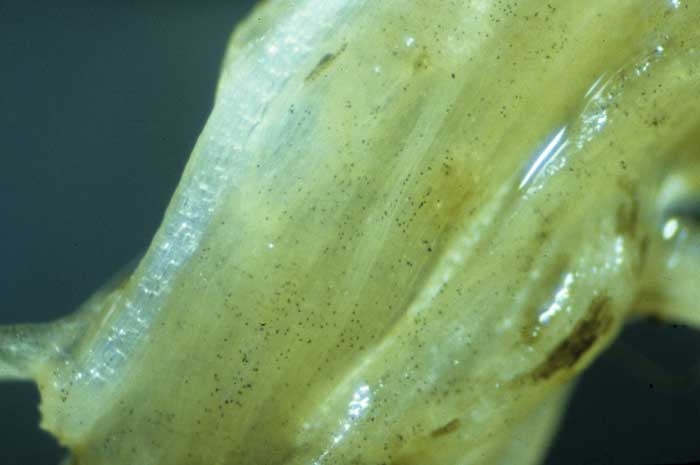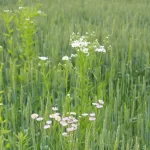Olpidium brassicae
Introduction
Olpidium brassicae is a common fungal parasite that infects the epidermal cells of plant roots, particularly those in the Brassicaceae family and tobacco plants [1]. It is commonly known as seedling blight of tobacco or seedling disease of cabbage. This pathogen has a significant economic impact on agriculture, as it can reduce the proportion of harvestable crop heads by preventing or delaying head formation and causing a decrease in head size [2]. In this blog, we will discuss the symptoms, life cycle and infection stages, growth conditions, prevention and control methods, and conclude with some recommendations for farmers dealing with the fungus .
Table of Hosts and Susceptibility to Olpidium brassicae infection
|
Hosts |
Susceptibility |
|
Cabbage |
High |
|
Broccoli |
High |
|
Tobacco |
High |
|
Cauliflower |
Moderate |
|
Brussels sprouts |
Moderate |
Other Olpidium species
Scientists are currently in the process of reorganizing the naming of Olpidium species. The crucifer-infecting species (and the tobacco pathogen) is called Olpidium brassicae, while the lettuce-associated species is known as Olpidium virulentus. Olpidium bornovanus has been associated with cucurbits, melons, and ornamental plants [3,4].
Table of Vector, Virus, and Hosts
| Olpidium species | Virus transmitted | Acronym | Host plant |
|
O. bornovanus
|
Cucumber necrosis virus | CNV | Cucumber |
| Cucumber leaf spot virus | CLSV | Cucumber | |
| Cucumber soil-borne virus | CSBV | Cucumber | |
| Melon necrotic spot virus | MNSV | Melon | |
| Squash necrosis virus | SqNV | Squash | |
| Red clover necrotic mosaic virus | RCNMV | Red clover | |
|
O. brassicae
|
Chenopodium necrosis virus | ChNV | Chenopodium |
| Lisianthus necrosis virus | LNV | Lisianthus | |
| Tobacco necrosis virus-A | TNV-A | Tobacco | |
| Tobacco necrosis virus-D | TNV-D | Tobacco | |
| Tulip mild mottle mosaic virus | TMMMV | Tulip | |
| Freesia sneak virus | FreSV | Freesia | |
| Lettuce ring necrosis virus | LRNV | Lettuce | |
| Olive mild mosaic virus | OMMV | Olive | |
|
O. virulentus
|
Mirafiori lettuce big-vein virus | MLBVV | Lettuce, Sonchus hydrophyllus, Actites sp.* |
| Lettuce big vein associated virus | LBVaV | Lettuce, S. hydrophyllus* | |
| Pepino mosaic virus | PepMV | Tomato | |
| Tobacco stunt virus | TStV | Tobacco |
Table from Maccarone (2013), https://doi.org/10.1094/PDIS-10-12-0979-FE
We provide great overviews of many agricultural microorganisms. Subscribe to stay updated!
Symptoms
Olpidium brassicae infection often results in no visible symptoms on the host plant [3]. However, it is significant because it can vector plant viruses such as tobacco necrosis virus, lettuce big vein virus, and tobacco necrosis virus [3]. It is also commonly seen with other aquatic fungi. In some cases, infected tobacco seedlings may exhibit root burn disease, which mainly affects plants in nurseries [4]. For cabbage, the fungus is often associated with the blackleg disease of cabbage shoots [5].
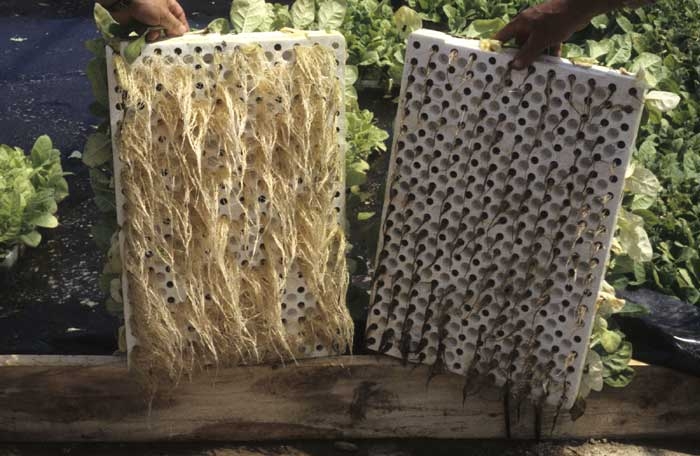
Life Cycle and Infection Stages
The life cycle of Olpidium brassicae consists of vegetative, asexual, and sexual stages [6]. The fungus releases zoospores through an exit tube from zoosporangia, which then move and encyst on the host plant’s epidermal cells and root hairs[6]. The infection begins with the fungus’s entry into the host plant, followed by the development of the thallus [6]. At maturity, zoospores with single posterior flagella are liberated from the root cell through spore exit tubes[7]. The fungus can also form star-shaped as it waits for a better environment to spread.
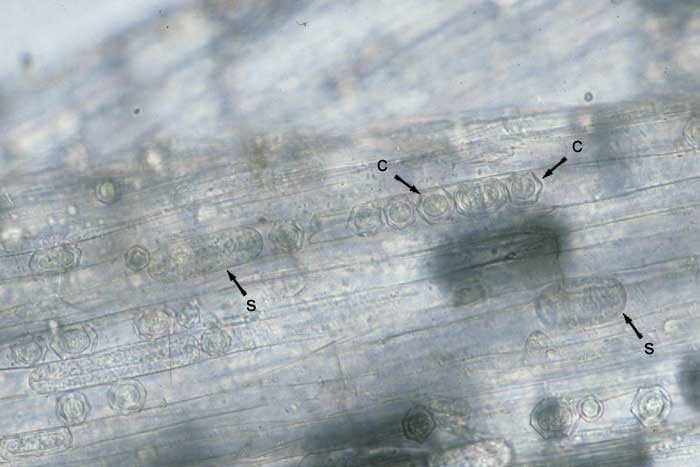
Growth Conditions for Olpidium brassicae
Olpidium brassicae is a globally widespread pathogen that can survive many years in the soil and on plant debris[8]. It can also be maintained on several intermediate hosts due to its polyphagia, including various market garden species such as salads and cucumbers[8]. The fungus finds favourable conditions for its development in the cortex cells in soilless cultures[8].
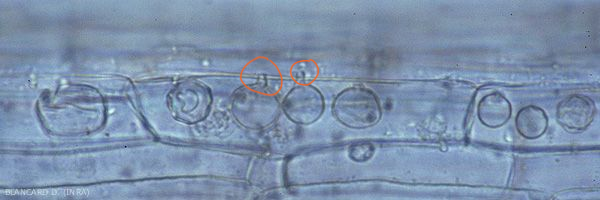
Methods of Prevention and Control
Preventing and controlling the infection can be challenging due to its ability to infect various weed species, which can act as reservoirs [2]. However, some strategies can help minimize the impact of this pathogen:
- Use healthy plants and seeds to avoid introducing the pathogen into the growing system
- Remove and destroy plant debris, particularly root systems, to prevent the spread of resting spores
- Implement proper soil/media/substrate preparation and drainage in future growing plots
- Monitor zoospore activity in water to reduce the risk of transmission in hydroponic systems
Conclusion
Olpidium brassicae is a fungal parasite that can have significant economic consequences for farmers, particularly those growing Brassicaceae crops. Understanding this pathogen’s life cycle, infection stages, and growth conditions is crucial for implementing effective prevention and control measures. By employing strategies such as crop rotation, weed management, soil sanitation, and planting resistant cultivars, farmers can minimize the impact of Olpidium brassicae on their crops and maintain a healthy, productive agricultural system.
Disclaimer
The information we present in Pathogen Profile is based on collating published peer-reviewed scientific literature, and sources we think are reliable. This is by no means an exhaustive review of pathogens. Pathogen Profile gives a small glimpse of what is known about pathogens. We encourage growers to do more research on the pathogens concerning their crops and hydroponic systems. We are not plant pathologists; thus, the information presented in the Pathogen Profile should not be used as professional advice to treat pathogens or operate your system.
References
- Lay, C.-Y., Hamel, C., & St-Arnaud, M. (2018). Taxonomy and pathogenicity of Olpidium brassicae and its allied species. Fungal Biology, 122(9), 837-846. (https://doi.org/10.1016/j.funbio.2018.04.012)
- Hartwright, L. M., Hunter, P. J., & Walsh, J. A. (2010). A comparison of Olpidium isolates from a range of host plants using internal transcribed spacer sequence analysis and host range studies. Fungal Biology, 114(1), 26-33. (https://doi.org/10.1016/j.mycres.2009.09.008)
- ScienceDirect. (n.d.). Olpidium brassicae – Agricultural and Biological Sciences. Retrieved from (https://www.sciencedirect.com/topics/agricultural-and-biological-sciences/olpidium-brassicae)
- INRAE. (n.d.). Tobacco – Root burn disease (Olpidium brassicae). Ephytia. Retrieved from (http://ephytia.inra.fr/en/C/10800/Tobacco-Root-burn-disease-Olpidium-brassicae)
- Dyakov, Y. T., & Zinovyeva, S. V. (2007). Plant parasite microorganisms. In Y. T. Dyakov, V. G. Dzhavakhiya, & T. Korpela (Eds.), Comprehensive and Molecular Phytopathology (pp. 19-47). Elsevier. (https://doi.org/10.1016/B978-044452132-3/50004-3)
- CABI PlantwisePlus Knowledge Bank. (2021). Olpidium brassicae (Olpidium seedling blight). Retrieved from (https://plantwiseplusknowledgebank.org/doi/10.1079/PWKB.Species.37321)
- Sekimoto, S., Rochon, D., Long, J. E., Dee, J. M., & Berbee, M. L. (2011). A multigene phylogeny of Olpidium and its implications for early fungal evolution. BMC Evolutionary Biology, 11(331). (https://doi.org/10.1186/1471-2148-11-331)
- INRAE. (n.d.). Tomato – Olpidium brassicae (Woronin) PA Dang (1886) – Root fungus. Ephytia. Retrieved from (http://ephytia.inra.fr/en/C/5011/Tomato-Olpidium-brassicae-Root-fungus)
![]()
David Santos is the COO/CMO of Healthy Hydroponics InnoTech


